Hello!
I'm a recent lurker who decided to dive into Eurorack after attending Moogfest with a friend this year.
I've committed the Eurorack sin of buying too many modules too quickly without a plan for what I ultimately want to build. Did I need 2x Mother 32s and a DFAM? Probably not, but Moogfest worked its magic. Here's a view of my current case. I own all the modules except for the Doepfer Wasp filter which I'm strongly considering ordering.
The ES-8 will be used to connect to my iPad and PC. My plan is to use VCVRack and Audulus to play with more unusual modules that I may not want to own in hardware form. So if there is a plan for my hardware rack, it has been to have bread and butter basics of Eurorack covered: VCOs, VCFs, VCAs, LFOs etc, plus have the ability to create some rhythmic patches.
I'd greatly appreciate any more experienced individual's opinion on how to expand. Maybe another LFO? Another VCA beyond the Doepfer quad?
Thanks much.
EDIT: Weird. The page for this setup has the correct current modules, but the linked image in this thread shows something else.


